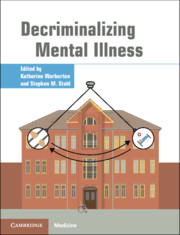Book contents
- Decriminalizing Mental Illness
- Decriminalizing Mental Illness
- Copyright page
- Contents
- Contributors
- Part I Introduction/Description of the Problem
- Part II Solutions
- Part III Psychopharmacological Treatment Considerations
- Part IV Nonpsychopharmacological Treatment Considerations
- Chapter 21 Neurocognition and Social Cognition Training as Treatments for Violence and Aggression in People with Severe Mental Illness
- Chapter 22 Examining Violence Among Not Guilty by Reason of Insanity State Hospital Inpatients Across Multiple Time Points: The Roles of Criminogenic Risk Factors and Psychiatric Symptoms
- Chapter 23 Criminogenic Risk and Mental Health: A Complicated Relationship
- Chapter 24 Implementation of a Specialized Treatment Program to Reduce Violence in a Forensic Population
- Chapter 25 From Trauma-Blind to Trauma-Informed: Rethinking Criminalization and the Role of Trauma in Persons with Serious Mental Illness
- Chapter 26 The Indistinguishables: Determining Appropriate Environments for Justice-Involved Individuals
- Chapter 27 Breaking Down Long-Term Chronic Aggression Within a Forensic Hospital System
- Part V Criminal Justice and Social Considerations
- Index
- References
Chapter 25 - From Trauma-Blind to Trauma-Informed: Rethinking Criminalization and the Role of Trauma in Persons with Serious Mental Illness
from Part IV - Nonpsychopharmacological Treatment Considerations
Published online by Cambridge University Press: 19 October 2021
- Decriminalizing Mental Illness
- Decriminalizing Mental Illness
- Copyright page
- Contents
- Contributors
- Part I Introduction/Description of the Problem
- Part II Solutions
- Part III Psychopharmacological Treatment Considerations
- Part IV Nonpsychopharmacological Treatment Considerations
- Chapter 21 Neurocognition and Social Cognition Training as Treatments for Violence and Aggression in People with Severe Mental Illness
- Chapter 22 Examining Violence Among Not Guilty by Reason of Insanity State Hospital Inpatients Across Multiple Time Points: The Roles of Criminogenic Risk Factors and Psychiatric Symptoms
- Chapter 23 Criminogenic Risk and Mental Health: A Complicated Relationship
- Chapter 24 Implementation of a Specialized Treatment Program to Reduce Violence in a Forensic Population
- Chapter 25 From Trauma-Blind to Trauma-Informed: Rethinking Criminalization and the Role of Trauma in Persons with Serious Mental Illness
- Chapter 26 The Indistinguishables: Determining Appropriate Environments for Justice-Involved Individuals
- Chapter 27 Breaking Down Long-Term Chronic Aggression Within a Forensic Hospital System
- Part V Criminal Justice and Social Considerations
- Index
- References
Summary
This article explores how wide-ranging effects of exposure to psychological trauma in mentally ill individuals continue to be largely overlooked, contributing to poor outcomes and a flood of mentally ill individuals into the court system and correctional care. Even in state hospitals and community mental health settings, the consequences of trauma often go unrecognized and untreated in highly vulnerable individuals. The authors posit that a trauma-informed lens is needed to move “trauma-blind” systems forward to more enlightened, evidence-based care and treatment. The traditional criminalization hypothesis refers to the funneling of SMI individuals into the criminal justice system as a result of deinstitutionalization and inadequate community mental health resources. This article explores how expanding notions about criminalization that identify factors beyond SMI still miss the mark by underestimating or omitting the role of trauma.
- Type
- Chapter
- Information
- Decriminalizing Mental Illness , pp. 258 - 265Publisher: Cambridge University PressPrint publication year: 2021

